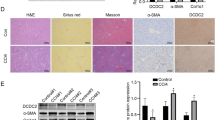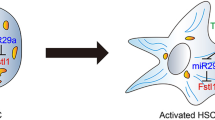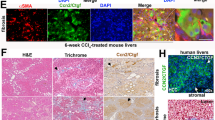Abstract
Nephroblastoma overexpressed gene encodes a matricellular protein (CCN3/NOV) of the CCN family, comprising CCN1 (CYR61), CCN2 (CTGF), CCN4 (WISP-1), CCN5 (WISP-2), and CCN6 (WISP-3). CCN proteins are involved in the regulation of mitosis, adhesion, apoptosis, extracellular matrix production, growth arrest and migration in multiple cell types. Compared to CCN2/CTGF, known as a profibrotic protein, the biological role of CCN3/NOV in liver fibrosis remains obscure. In this study we showed ccn3/nov mRNA to increase dramatically following hepatic stellate cell activation, reaching peak levels in fully transdifferentiated myofibroblasts. In models of experimental hepatic fibrosis, CCN3/NOV increased significantly at the mRNA and protein levels. CCN3/NOV was found mainly in non-parenchymal cells along the areas of tissue damage and repair. In the bile-duct ligation model, CCN3/NOV was localized mainly along portal tracts, while the repeated application of carbon tetrachloride resulted in CCN3/NOV expression mainly in the centrilobular areas. In contrast to CCN2/CTGF, the profibrotic cytokines platelet-derived growth factor-B and -D as well as transforming growth factor-β suppressed CCN3/NOV expression. In vitro, CCN3/NOV siRNA attenuated migration in the cirrhotic fat storing cell line CFSC well in line with in vivo findings that various types of cells expressing CCN3/NOV migrate into the area of tissue damage and regeneration. The suppression of CCN3/NOV enhanced expression of profibrotic marker proteins, such as α-smooth muscle actin, collagen type I, fibronectin, CCN2/CTGF and TIMP-1 in primary rat hepatic stellate cells and in CFSC. We further found that adenoviral overexpression of CCN2/CTGF suppressed CCN3/NOV expression, while the overexpression of CCN3/NOV as well as the suppression of CCN3/NOV by targeting siRNAs both resulted in enhanced CCN2/CTGF expression. These results indicate the complexity of CCN actions that are far beyond the classic Yin/Yang interplay.






Similar content being viewed by others
Abbreviations
- Ad5:
-
adenovirus type 5
- α-SMA:
-
α-smooth muscle actin
- BDL:
-
bile duct ligation
- CCN2/CTGF:
-
connective tissue growth factor
- CCN3/NOV:
-
Nephroblastoma overexpressed gene
- CFSC:
-
cirrhotic fat storing cells
- EMT:
-
epithelial-to-mesenchymal transition
- HSC:
-
hepatic stellate cells
- KC:
-
Kupffer cell(s)
- LSEC:
-
liver sinusoidal endothelial cell(s)
- MFB:
-
myofibroblast(s)
- MMP:
-
matrix metalloproteinase
- PDGF:
-
platelet-derived growth factor
- PDGFRβ:
-
platelet-derived growth factor receptor type β
- pMF:
-
periportal myofibroblasts
- TGF-β:
-
transforming growth factor-β
- TIMP-1:
-
tissue inhibitor of metalloproteinases-1.
References
Abreu JG, Ketpura NI, Reversade B, De Robertis EM (2002) Connective-tissue growth factor (CTGF) modulates cell signalling by BMP and TGF-β. Nat Cell Biol 4:599–604
Arias M, Sauer-Lehnen S, Treptau J, Janoschek N, Theuerkauf I, Buettner R, Gressner AM, Weiskirchen R (2003) Adenoviral expression of a transforming growth factor-beta1 antisense mRNA is effective in preventing liver fibrosis in bile-duct ligated rats. BMC Gastroenterol 3:29
Benini S, Perbal B, Zambelli D, Colombo MP, Manara MC, Serra M, Parenza M, Martinez V, Picci P, Scotlandi K (2005) In Ewing’s sarcoma CCN3(NOV) inhibits proliferation while promoting migration and invasion of the same cell type. Oncogene 24:4349–4361
Bleau AM, Planque N, Lazar N, Zambelli D, Ori A, Quan T, Fisher G, Scotlandi K, Perbal B (2007) Antiproliferative activity of CCN3: involvement of the C-terminal module and post-translational regulation. J Cell Biochem 101:1475–1491
Bohr W, Kupper M, Hoffmann K, Weiskirchen R (2010) Recombinant expression, purification, and functional characterisation of connective tissue growth factor and nephroblastoma-overexpressed protein. PLoS One 5(12):e16000
Bork P (1993) The modular architecture of a new family of growth regulators related to connective tissue growth factor. FEBS Lett 327:125–130
Borkham-Kamphorst E, Herrmann J, Stoll D, Treptau J, Gressner AM, Weiskirchen R (2004a) Dominant-negative soluble PDGF-β receptor inhibits hepatic stellate cell activation and attenuates liver fibrosis. Lab Invest 84:766–777
Borkham-Kamphorst E, Stoll D, Gressner AM, Weiskirchen R (2004b) Inhibitory effect of soluble PDGF-β receptor in culture-activated hepatic stellate cells. Biochem Biophys Res Commun 318:451–462
Borkham-Kamphorst E, van Roeyen CR, Ostendorf T, Floege J, Gressner AM, Weiskirchen R (2007) Pro-fibrogenic potential of PDGF-D in liver fibrosis. J Hepatol 46:1064–1074
Borkham-Kamphorst E, Kovalenko E, van Roeyen CR, Gassler N, Bomble M, Ostendorf T, Floege J, Gressner AM, Weiskirchen R (2008) Platelet-derived growth factor isoform expression in carbon tetrachloride-induced chronic liver injury. Lab Invest 88:1090–1100
Bradham DM, Igarashi A, Potter RL, Grotendorst GR (1991) Connective tissue growth factor: a cysteine-rich mitogen secreted by human vascular endothelial cells is related to the SRC-induced immediate early gene product CEF-10. J Cell Biol 114:1285–1294
Brunner A, Chinn J, Neubauer M, Purchio AF (1991) Identification of a gene family regulated by transforming growth factor-β. DNA Cell Biol 10:293–300
Fehrenbach H, Weiskirchen R, Kasper M, Gressner AM (2001) Upregulated expression of the receptor for advanced glycation end products in cultured rat hepatic stellate cells during transdifferentiation to myofibroblasts. Hepatology 34:943–952
Gao R, Ball DK, Perbal B, Brigstock DR (2004) Connective tissue growth factor induces c-fos gene activation and cell proliferation through p44/42 MAP kinase in primary rat hepatic stellate cells. J Hepatol 40:431–438
Greenwel P, Schwartz M, Rosas M, Peyrol S, Grimaud JA, Rojkind M (1991) Characterization of fat-storing cell lines derived from normal and CCl4-cirrhotic livers. Differences in the production of interleukin-6. Lab Invest 65:644–653
Greenwel P, Rubin J, Schwartz M, Hertzberg EL, Rojkind M (1993) Liver fat-storing cell clones obtained from a CCl4-cirrhotic rat are heterogeneous with regard to proliferation, expression of extracellular matrix components, interleukin-6, and connexin 43. Lab Invest 69:210–216
Gupta N, Wang H, McLeod TL, Naus CC, Kyurkchiev S, Advani S, Yu J, Perbal B, Weichselbaum R (2001) Inhibition of glioma cell growth and tumorigenic potential by CCN3 (NOV). Mol Pathol 54:293–299
Hirasaki S, Koide N, Ujike K, Shinji T, Tsuji T (2001) Expression of Nov, CYR61 and CTGF genes in human hepatocellular carcinoma. Hepatol Res 19:294–305
Joliot V, Martinerie C, Dambrine G, Plassiart G, Brisac M, Crochet J, Perbal B (1992) Proviral rearrangements and overexpression of a new cellular gene (nov) in myeloblastosis-associated virus type 1-induced nephroblastomas. Mol Cell Biol 12:10–21
Kawaki H, Kubota S, Suzuki A, Lazar N, Yamada T, Matsumura T, Ohgawara T, Maeda T, Perbal B, Lyons KM, Takigawa M (2008) Cooperative regulation of chondrocyte differentiation by CCN2 and CCN3 shown by a comprehensive analysis of the CCN family proteins in cartilage. J Bone Miner Res 23:1751–1764
Lafont J, Laurent M, Thibout H, Lallemand F, Le Bouc Y, Atfi A, Martinerie C (2002) The expression of novH in adrenocortical cells is down-regulated by TGFβ1 through c-Jun in a Smad-independent manner. J Biol Chem 277:41220–41229
Leask A, Chen S, Pala D, Brigstock DR (2008) Regulation of CCN2 mRNA expression and promoter activity in activated hepatic stellate cells. J Cell Commun Signal 2:49–56
Lee SH, Seo GS, Park YN, Sohn DH (2004) Nephroblastoma overexpressed gene (NOV) expression in rat hepatic stellate cells. Biochem Pharmacol 68:1391–1400
Lin CG, Chen CC, Leu SJ, Grzeszkiewicz TM, Lau LF (2005) Integrin-dependent functions of the angiogenic inducer NOV (CCN3): implication in wound healing. J Biol Chem 280:8229–8237
Liu C, Liu XJ, Crowe PD, Kelner GS, Fan J, Barry G, Manu F, Ling N, De Souza EB, Maki RA (1999) Nephroblastoma overexpressed gene (NOV) codes for a growth factor that induces protein tyrosine phosphorylation. Gene 238:471–478
Minamizato T, Sakamoto K, Liu T, Kokubo H, Katsube K, Perbal B, Nakamura S, Yamaguchi A (2007) CCN3/NOV inhibits BMP-2-induced osteoblast differentiation by interacting with BMP and Notch signaling pathways. Biochem Biophys Res Commun 354:567–573
Nevzorova YA, Tschaharganeh D, Gassler N, Geng Y, Weiskirchen R, Sicinski P, Trautwein C, Liedtke C (2009) Aberrant cell cycle progression and endoreplication in regenerating livers of mice that lack a single E-type cyclin. Gastroenterology 137:691–703
Pinzani M, Gesualdo L, Sabbah GM, Abboud HE (1989) Effects of platelet-derived growth factor and other polypeptide mitogens on DNA synthesis and growth of cultured rat liver fat-storing cells. J Clin Invest 84:1786–1793
Riser BL, Najmabadi F, Perbal B, Peterson DR, Rambow JA, Riser ML, Sukowski E, Yeger H, Riser SC (2009) CCN3 (NOV) is a negative regulator of CCN2 (CTGF) and a novel endogenous inhibitor of the fibrotic pathway in an in vitro model of renal disease. Am J Pathol 174:1725–1734
Riser BL, Najmabadi F, Perbal B, Rambow JA, Riser ML, Sukowski E, Yeger H, Riser SC, Peterson DR (2010) CCN3/CCN2 regulation and the fibrosis of diabetic renal disease. J Cell Commun Signal 4:39–50
Rydziel S, Stadmeyer L, Zanotti S, Durant D, Smerdel-Ramoya A, Canalis E (2007) Nephroblastoma overexpressed (Nov) inhibits osteoblastogenesis and causes osteopenia. J Biol Chem 282:19762–18772
Schäfer S, Zerbe O, Gressner AM (1987) The synthesis of proteoglycans in fat-storing cells of rat liver. Hepatology 7:680–687
Sin WC, Tse M, Planque N, Perbal B, Lampe PD, Naus CC (2009) Matricellular protein CCN3 (NOV) regulates actin cytoskeleton reorganization. J Biol Chem 284:29935–29944
Soret J, Dambrine G, Perbal B (1989) Induction of nephroblastoma by myeloblastosis-associated virus type 1: state of proviral DNAs in tumor cells. J Virol 63:1803–1807
Thibout H, Martinerie C, Créminon C, Godeau F, Boudou P, Le Bouc Y, Laurent M (2003) Characterization of human NOV in biological fluids: an enzyme immunoassay for the quantification of human NOV in sera from patients with diseases of the adrenal gland and of the nervous system. J Clin Endocrinol Metab 88:327–336
Tong Z, Chen R, Alt DS, Kemper S, Perbal B, Brigstock DR (2009) Susceptibility to liver fibrosis in mice expressing a connective tissue growth factor transgene in hepatocytes. Hepatology 50:939–947
van Roeyen CR, Eitner F, Scholl T, Boor P, Kunter U, Planque N, Gröne HJ, Bleau AM, Perbal B, Ostendorf T, Floege J (2008) CCN3 is a novel endogenous PDGF-regulated inhibitor of glomerular cell proliferation. Kidney Int 73:86–94
Weiskirchen R (2011) CCN proteins in liver health and disease. Front Biosci 16:1939–1961
Weiskirchen R, Bister K (1993) Suppression in transformed avian fibroblasts of a gene (crp) encoding a cysteine-rich protein containing LIM domains. Oncogene 8:2317–2324
Weiskirchen R, Kneifel J, Weiskirchen S, van de Leur E, Kunz D, Gressner AM (2000) Comparative evaluation of gene delivery devices in primary cultures of rat hepatic stellate cells and rat myofibroblasts. BMC Cell Biol 1:4
Zeng ZJ, Yang LY, Ding X, Wang W (2004) Expressions of cysteine-rich 61, connective tissue growth factor and Nov genes in hepatocellular carcinoma and their clinical significance. World J Gastroenterol 10:3414–3418
Acknowledgements
This work was supported by the Deutsche Forschungsgemeinschaft (SFB/TRR57) to RW. We wish to extend our special thanks to U. Haas and G. Dietzel for their kind assistance.
Author information
Authors and Affiliations
Corresponding authors
Electronic supplementary material
Below is the link to the electronic supplementary material.
Suppl. Fig. 1
Expression of CCN3/NOV in liver cell subpopulation and during transdifferentiation. (A) Quantitative RT-PCR analysis (TaqMan) from culture-activated HSC showing significant upregulation of CCN3/NOV, CCN2/CTGF and α-SMA that reach peak levels in fully transdifferentiated MFB. (B) No CCN3/NOV expression was found in naive hepatocytes that were cultured for indicated time intervals. (C) A standard RT-PCR for analysis of CCN3/NOV expression in different primary liver cells that were cultured for indicated time intervals was performed showing minimal expression in Kupffer cells (KC) and sinusoidal endothelial cells (SLEC) compared to culture-activated HSC and periportal miofibroblasts (pMF) in secondary culture (D) Double staining immunohistochemistry of CCN3/NOV (green) and ED2 (red). ED2, a specific Kupffer cell marker, showed no co-localization with CCN3/NOV (PPT 11.2 MB)
Suppl. Fig. 2
CCN3/NOV and PDGF signalling. (A) CFSC were transfected with control siRNA and CCN3/NOV siRNAs and starved for 24 h followed by stimulation with PDGF-B (20 ng/ml) for 15 min. Western blot analysis of respective cell lysates showed no effects of CCN3/NOV siRNA in PDGF-induced phosphorylation of PDGF receptors, AKT, ERK1/2, and p38. (B) The efficacy of CCN3/NOV knock down was confirmed in CCN3/NOV ELISA using cell supernatants taken from the same set of experiments (PPT 145 kb)
Rights and permissions
About this article
Cite this article
Borkham-Kamphorst, E., van Roeyen, C.R., Van de Leur, E. et al. CCN3/NOV small interfering RNA enhances fibrogenic gene expression in primary hepatic stellate cells and cirrhotic fat storing cell line CFSC. J. Cell Commun. Signal. 6, 11–25 (2012). https://doi.org/10.1007/s12079-011-0141-3
Received:
Accepted:
Published:
Issue Date:
DOI: https://doi.org/10.1007/s12079-011-0141-3




